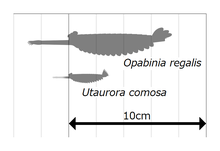| Opabiniidae Temporal range: Middle Cambrian - Middle Ordovician, 507–475 Ma PreꞒ Ꞓ O S D C P T J K Pg N | |
|---|---|

| |
| Opabinia (top) and Utaurora (bottom) | |
| Scientific classification | |
| Domain: | Eukaryota |
| Kingdom: | Animalia |
| Phylum: | Arthropoda |
| Stem group: | †Dinocaridida |
| Family: | †Opabiniidae Walcott, 1912 |
| Genera | |
Opabiniidae is an extinct family of marine stem-arthropods. Its type and best-known genus is Opabinia. It also contains Utaurora, and Mieridduryn. Opabiniids closely resemble radiodonts, but their frontal appendages were basally fused into a proboscis. Opabiniids also distinguishable from radiodonts by setal blades covering at least part of the body flaps and serrated caudal rami.


History of study
Opabiniidae was named by Charles Doolittle Walcott in 1912, alongside its type species Opabinia. Walcott interpreted Opabiniidae as a family of anostracan crustaceans, most closely related to Thamnocephalidae. Opabinia was restudied in the 1970s, and reinterpreted as a stranger animal. Stephen Jay Gould referred to Opabinia as a "weird wonder", and an illustration of Opabinia prompted laughter when it was first revealed at a paleontological conference. In 2022, more opabiniids were discovered. That being Utaurora, and Mieridduryn.
Myoscolex from Emu Bay Shale is sometimes suggested to be an opabiniid, but morphological features supporting this interpretation are controversial.
References
- Tamisiea, Jack (8 February 2022). "One of Evolution's Oddest Creatures Finds a Fossilized Family Member - Opabinia, which swam the seas of Earth's Cambrian era some 500 million years ago, was not just a one hit wonder". The New York Times. Retrieved 10 February 2022.
- ^ Pates et al. 2022.
- Walcott 1912.
- Whittington 1975.
- Briggs, D. E. G.; Nedin, C. (1997). "The Taphonomy and Affinities of the Problematic Fossil Myoscolex from the Lower Cambrian Emu Bay Shale of South Australia". Journal of Paleontology. 71 (1): 22–32. doi:10.1017/S0022336000038919. JSTOR 1306537. S2CID 131851540.
- Dzik, Jerzy (2004). "Anatomy and relationships of the Early Cambrian worm Myoscolex". Zoologica Scripta. 33 (1): 57–69. doi:10.1111/j.1463-6409.2004.00136.x. ISSN 1463-6409. S2CID 85216629.
Works cited
- Pates, Stephen; Wolfe, Joanna M.; Lerosey-Aubril, Rudy; Daley, Allison C.; Ortega-Hernández, Javier (9 February 2022). "New opabiniid diversifies the weirdest wonders of the euarthropod stem group". Proceedings of the Royal Society B: Biological Sciences. 289 (1968). doi:10.1098/rspb.2021.2093. PMC 8826304. PMID 35135344.
- Walcott, Charles D. (13 March 1912). "Cambrian geology and paleontology II: No. 6.—Middle Cambrian Branchiopoda, Malacostraca, Trilobita, and Merostomata". Smithsonian Miscellaneous Collections. 57 (6).
- Whittington, H. B. (26 June 1975). "The enigmatic animal Opabinia regalis, Middle Cambrian, Burgess Shale, British Columbia". Philosophical Transactions of the Royal Society of London. Series B, Biological Sciences. 271 (910): 1–43. Bibcode:1975RSPTB.271....1W. doi:10.1098/rstb.1975.0033. JSTOR 2417412.
| Dinocaridida | ||||||||||
|---|---|---|---|---|---|---|---|---|---|---|
| ||||||||||
| Dinocaridida |
|  | ||||||||
| Taxon identifiers | |
|---|---|
| Opabiniidae | |